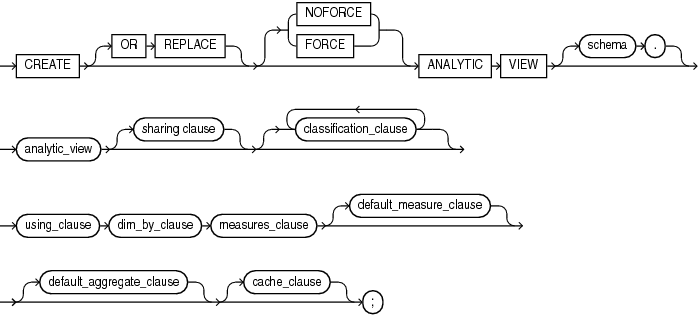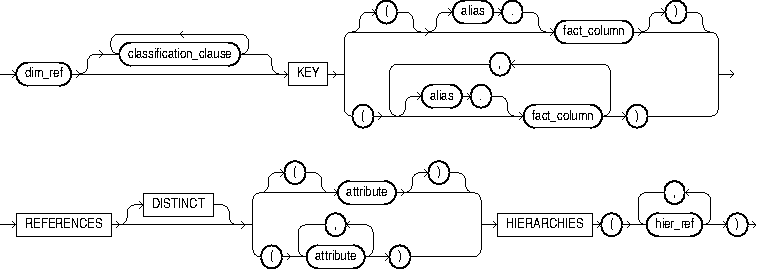CREATE ANALYTIC VIEW
Purpose
Use the CREATE ANALYTIC VIEW statement to create an analytic view. An analytic view specifies the source of its fact data and defines measures that describe calculations or other analytic operations to perform on the data. An analytic view also specifies the attribute dimensions and hierarchies that define the rows of the analytic view.
Tip:
You can view and run SQL scripts that create analytic views at the Oracle Live SQL website at https://livesql.oracle.com/apex/livesql/file/index.html. The website has scripts and tutorials that demonstrate the creation and use of analytic views.Prerequisites
To create an analytic view in your own schema, you must have the CREATE ANALYTIC VIEW system privilege. To create an analytic view in another user's schema, you must have the CREATE ANY ANALYTIC VIEW system privilege.
Syntax
create_analytic_view::=
sharing_clause::=
classification_clause::=
using_clause::=
dim_by_clause::=
dim_key::=
dim_ref::=
hier_ref::=
measures_clause::=
av_measure::=
base_measure_clause::=
calc_measure_clause::=
meas_aggregate_clause::=
default_measure_clause::=
default_aggregate_clause::=
cache_clause::=
cache_specification::=
levels_clause::=
level_specification::=
Semantics
OR REPLACE
Specify OR REPLACE to replace an existing definition of an analytic view with a different definition.
FORCE and NOFORCE
Specify FORCE to force the creation of the analytic view even if it does not successfully compile. If you specify NOFORCE, then the analytic view must compile successfully, otherwise an error occurs. The default is NOFORCE.
schema
Specify the schema in which to create the analytic view. If you do not specify a schema, then Oracle Database creates the analytic view in your own schema.
analytic_view
Specify a name for the analytic view.
sharing_clause
Specify whether to create the analytic view as an application common object. Specifying METADATA shares the analytic view's metadata, but its data is unique to each container. Specifying DATA shares the analytic view object; its data is the same for all containers in the application container and the data is stored only in the application root. Specifying NONE excludes the analytic view from being shared.
classification_clause
Use the classification clause to specify values for the CAPTION or DESCRIPTION classifications and to specify user-defined classifications. Classifications provide descriptive metadata that applications may use to provide information about analytic views and their components.
You may specify any number of classifications for the same object. A classification can have a maximum length of 4000 bytes.
For the CAPTION and DESCRIPTION classifications, you may use the DDL shortcuts CAPTION 'caption' and DESCRIPTION 'description' or the full classification syntax.
You may vary the classification values by language. To specify a language for the CAPTION or DESCRIPTION classification, you must use the full syntax. If you do not specify a language, then the language value for the classification is NULL. The language value must either be NULL or a valid NLS_LANGUAGE value.
using_clause
Specify a fact table or view. External and remote tables are permitted. You may specify a table or view in another schema. You can specify an alias for the table or view.
dim_by_clause
Specify the attribute dimensions of the analytic view.
dim_key
Specify an attribute dimension, columns of the fact table, columns of the attribute dimension, and hierarchies that are related in the analytic view.
With the KEY keyword, specify one or more columns in the fact table.
With the REFERENCES keyword, specify attributes of the attribute dimensions that the analytic view is dimensioned by. Each attribute must be a level key. The DISTINCT keyword supports the use of denormalized fact tables, in which the attribute dimension and fact data are in the same table. Use REFERENCES DISTINCT when an attribute dimension is defined using the fact table.
With the HIERARCHIES keyword, specify the hierarchies in the analytic view that use the attribute dimension.
dim_ref
Specify an attribute dimension. You can specify an alias for an attribute dimension, which is required if you use the same dimension more than once or if you use multiple dimensions with the same name from different schemas.
hier_ref
Specify a hierarchy. You can specify an alias for a hierarchy. You can specify one of the hierarchies in the list as the default. If you do not specify a default, the first hierarchy in the list is the default.
measures_clause
Specify the measures for the analytic view.
av_measure
Define a measure using either a single fact column or an expression over measures in this analytic view. A measure can be either a base measure or a calculated measure.
base_measure_clause
Define a base measure by optionally specifying a fact column or a meas_aggregate_clause, or both. If you do not specify a fact column, then the analytic view uses the column of the fact table that has the same name as the measure. If a column by the same name does not exist, an error is raised.
calc_measure_clause
Define a calculated measure by specifying an analytic view expression. The expression may reference other measures in the analytic view, but may not reference fact columns. Calculated measures do not have an aggregate clause because they're computed over the aggregated base measures.
For the syntax and descriptions of analytic view expressions, see Analytic View Expressions.
default_measure_clause
Specify a measure to use as the default measure for the analytic view. If you do not specify a measure, the first measure defined is the default.
meas_aggregate_clausè
Specify a default aggregation operator for a base measure. If you do not specify an aggregation operator, then the operator specified by the default_aggregate_clause is used.
default_aggregate_clause
Specify a default aggregation for all base measures in the analytic view. If you do not specify a default aggregation, then the default value is SUM.
cache_clause
Specify a cache clause to improve query response time when an appropriate materialized view is available. You can specify one or more cache specifications.
cache_specification
Specify one or more measure groups for a cache clause. To include all measure groups, specify ALL. Each measure group can contain one or more measures and one or more level groupings. A level grouping can contain one or more level specifications.
level_specification
Specify one or more levels for a level grouping of a measure group for a cache specification. Specify only one level per hierarchy. A materialized view must exist that contains the aggregated values for the hierarchy level.
Examples
The following is a description of the SALES_FACT table:
desc SALES_FACT
Name Null? Type
----------------- ----- -------------
MONTH_ID VARCHAR2(10)
CATEGORY_ID NUMBER(6)
STATE_PROVINCE_ID VARCHAR2(120)
UNITS NUMBER(6)
SALES NUMBER(12,2)The following example creates the SALES_AV analytic view using the SALES_FACT table:
CREATE OR REPLACE ANALYTIC VIEW sales_av
USING sales_fact
DIMENSION BY
(time_attr_dim -- An attribute dimension of time data
KEY month_id REFERENCES month_id
HIERARCHIES (
time_hier DEFAULT),
product_attr_dim -- An attribute dimension of product data
KEY category_id REFERENCES category_id
HIERARCHIES (
product_hier DEFAULT),
geography_attr_dim -- An attribute dimension of store data
KEY state_province_id
REFERENCES state_province_id HIERARCHIES (
geography_hier DEFAULT)
)
MEASURES
(sales FACT sales, -- A base measure
units FACT units, -- A base measure
sales_prior_period AS -- Calculated measures
(LAG(sales) OVER (HIERARCHY time_hier OFFSET 1)),
sales_year_ago AS
(LAG(sales) OVER (HIERARCHY time_hier OFFSET 1
ACROSS ANCESTOR AT LEVEL year)),
chg_sales_year_ago AS
(LAG_DIFF(sales) OVER (HIERARCHY time_hier OFFSET 1
ACROSS ANCESTOR AT LEVEL year)),
pct_chg_sales_year_ago AS
(LAG_DIFF_PERCENT(sales) OVER (HIERARCHY time_hier OFFSET 1
ACROSS ANCESTOR AT LEVEL year)),
sales_qtr_ago AS
(LAG(sales) OVER (HIERARCHY time_hier OFFSET 1
ACROSS ANCESTOR AT LEVEL quarter)),
chg_sales_qtr_ago AS
(LAG_DIFF(sales) OVER (HIERARCHY time_hier OFFSET 1
ACROSS ANCESTOR AT LEVEL quarter)),
pct_chg_sales_qtr_ago AS
(LAG_DIFF_PERCENT(sales) OVER (HIERARCHY time_hier OFFSET 1
ACROSS ANCESTOR AT LEVEL quarter))
)
DEFAULT MEASURE SALES;

















